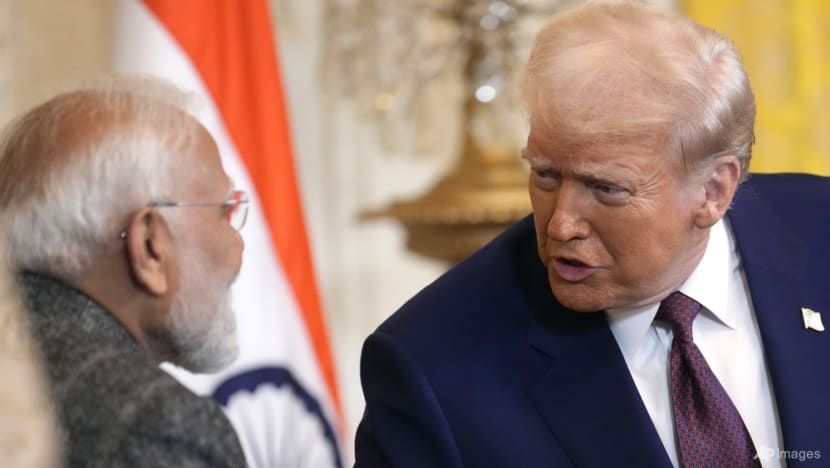Commentary: How the US weaponised Pakistan against India
Prime Minister Narendra Modi and New Delhi’s policymakers may have overestimated their leverage with US President Donald Trump, says Mihir Sharma for Bloomberg Opinion.

US President Donald Trump speaks with India's Prime Minister Narendra Modi during a news conference in the East Room of the White House, Feb 13, 2025, in Washington. (AP Photo/Ben Curtis, File)
NEW DELHI: Many in New Delhi welcomed President Donald Trump’s return to power, expecting him to take the Indo-US relationship to new heights.
They must wonder where it all went wrong, given that Trump launched an unprecedented broadside against India this week – threatening tariffs of 25 per cent and warning that a surcharge would be added unless India stops buying Russian oil and weapons. He even expressed dissatisfaction with the nation’s participation in the “anti-US” BRICS grouping.
Normally, Prime Minister Narendra Modi might just overlook a few social media posts. It may be humiliating to wind up with higher tariff rates than India’s peers after wooing Trump, but that can be shrugged off as well.
Yet the president didn’t stop at trade. He twisted the knife by announcing a tariff deal with Pakistan on the very same day – and added that US companies would help India’s troubled neighbour extract oil from recently discovered reserves, and that “maybe they’ll be selling oil to India one day.”
I’m not sure Trump knows what he’s playing with. Yes, the government was looking forward to a more transactional era: For New Delhi, almost everything is negotiable. But not its relationship with Pakistan.
Citizens already resented Trump claiming credit for a ceasefire between the nuclear-armed nations earlier this year. Nothing is more likely to cause any Indian leader to dig in his heels and stop talking about economic ties than a mention of Pakistan.
INDIA HAS LITTLE LEVERAGE
Policymakers are grimly absorbing some unpalatable truths. Has New Delhi overestimated its geopolitical importance? The tariff threat was bad enough: 25 per cent is higher than the 19 per cent agreed with the Philippines and Indonesia, and much higher than the 15 per cent offered to US allies like the European Union, Korea and Japan.
For some reason, India expected it was so indispensable to the US that it would receive a better deal than long-term allies – even one that preserved the barriers it has erected around industry and agriculture. Instead, unless it gives away far more than planned, it might wind up as one of the few countries that emerged from Trump’s tariff “pause” with a higher, not lower rate than was originally threatened.
New Delhi has learned, too late, that it has very little actual leverage in Washington. The Chinese may be granted another extension because they have things that they can threaten the US economy with. The Europeans and East Asians can promise to buy American-made weaponry or invest in the US. India can neither threaten nor bribe.
For years, it has nevertheless managed to punch above its actual economic weight by tacitly promising to be part of Washington-led attempts to contain a rising China. Tacitly, not openly, mind – India doesn’t believe that closeness to the US precludes it from participating in China-dominated groupings or supporting Beijing’s clients in Moscow.
But Trump’s ire demonstrates that this balancing act has may finally have run its course. Russia might not be his top priority, but its second-largest client’s refusal to fall in line will still irritate him. He received fulsome praise from Pakistan’s leaders after he announced a ceasefire; the Indians pointedly ignored him.
This White House wants homage, not defiance. There was certainly a cantankerous edge to his remark that, for all he cared, India and Russia could “take their dead economies down together”.
INDIA’S US POLICY IS IN SHAMBLES
Had he merely demanded more distance between Delhi and Moscow – and done so, if possible, without insulting India’s economic prospects – leaders might well have quietly given in. The discount on Russian oil is only between US$6 and US$10 a barrel, and according to research from Standard Chartered, the impact on inflation of switching to US sources would be negligible.
Sure, the government would have to somehow convince its nationalist base that the switch would be in the country’s interest after spending two years claiming the opposite. But trust in the prime minister is high enough for him to pull that off.
What voters won’t accept, however, is any dilution of the government’s hard line on Pakistan. Capitulation to Trump after he has signalled he prefers their neighbours would be a tough sell, even for Modi.
In less than 24 hours, New Delhi’s policy for the Trump era, and its carefully cultivated strategic ambiguity amid US-China tension, were both left in shambles. I expect Modi will still be able to push through some sort of deal, if with more concessions and domestic political damage than he would like. But Trump is clearly asking himself exactly what India brings to the table as a partner.
Equally, citizens will wonder if the US is once again making the mistake – as it has so often before – of trusting Pakistan’s establishment while ignoring India. New Delhi’s confidence that it could navigate the Trump era has been well and truly shattered; it will take a long time for the relationship to recover from this tumultuous week.














